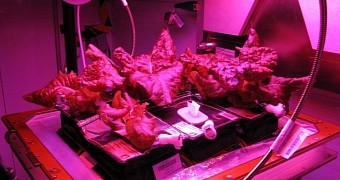Astronauts aboard the International Space Station have officially become the first people ever to eat food grown not here on Earth, as run-of-the-mill hamburgers and donuts are, but out in space.
Just hours ago, the space explorers harvested a batch of red romaine lettuce that was planted on July 8 and took a few bites of the leafy treat.
They first sampled the lettuce bare. Then, they decided to try and actually make a meal out of it by adding some oil and vinegar. It wasn't to die for, what with it being lettuce and all, but it wasn't all that bad either.
Mind you, the lettuce that the International Space Station crew got to feast on was by no means the first crop ever sent to grow in our planet's orbit rather than with its roots deep in the ground, as nature intended.
It was, however, the first harvest that wasn't simply sent back to Earth for analysis but was instead turned into salad and eaten out in orbit.
“The fresh red romaine lettuce that accompanied the crew’s usual freeze-dried fare is far from the first crop grown on a space station,” NASA says.
“For decades, NASA and other agencies have experimented with plants in space, but the results were always sent to Earth for examination, rather than eaten,” the US space agency goes on to detail.
It wasn't easy growing the lettuce
The red romaine lettuce eaten by astronauts aboard the International Space Station was grown with the help of a carefully designed system known as Veggie.
This system, the result of a collaboration between Orbital Technologies and the Kennedy Space Center, uses LEDs to encourage crops to grow. Besides, it adapts to the needs of specific plants.
To prevent accelerated ripening and decay, the greenhouse in which the lettuce was grown was also equipped with technology to destroy compounds known to speed up these processes, as well as bacteria, fungi and other organisms known to affects crops.
What's more, the red romaine lettuce was forever watched by a system that constantly measured the thickness and water content of its leaves and alerted astronauts whenever it needed watering.
It was hard work for just a salad, but at the end of the day, it was all worth it. More so since proving that edible crops can be grown in orbit is a prerequisite to exploring deep space and establishing colonies on other planets.
“Plants will be an integral part of any life-support system for extended missions, providing food and oxygen and processing waste,” NASA explains.
After trying the lettuce plain, @astro_kjell and @StationCDRKelly added oli & vinegar! #NASAVEGGIE pic.twitter.com/x80gOosMhu
— ISS Research (@ISS_Research) August 10, 2015

 14 DAY TRIAL //
14 DAY TRIAL // 